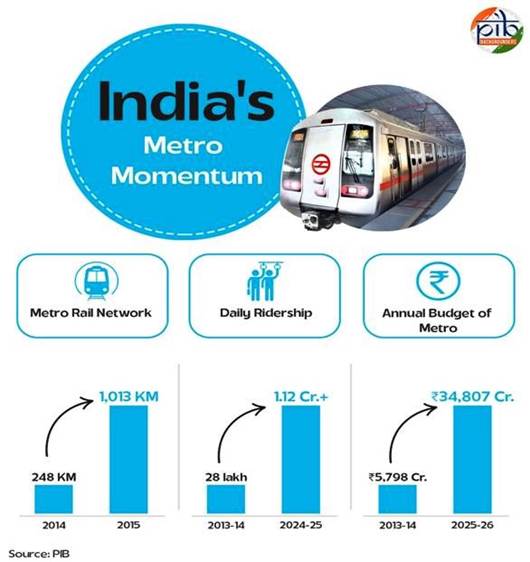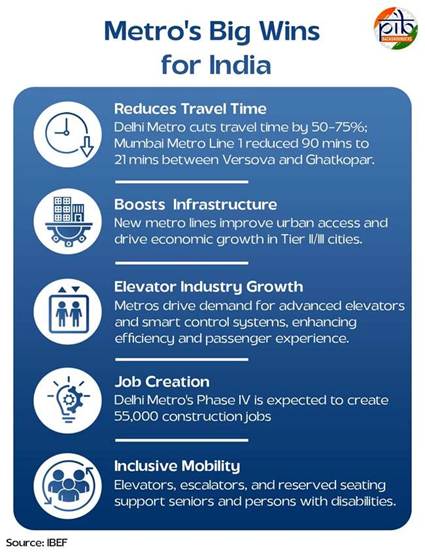Content
- A Flame that Warms the Heart: The Ujjwala Story
- India’s Metro Revolution: From Miles to Milestones
A Flame that Warms the Heart: The Ujjwala Story
Background & Context
- Traditional cooking fuels in rural India (pre-2016)
- Firewood – Collected from forests or common lands, high smoke emissions, time-intensive.
- Cow dung cakes – Widely used in villages, slow-burning but heavy smoke.
- Coal – Used in semi-urban/rural belts, emitted dense particulates.
- Crop residues – Seasonal fuel, produced significant indoor air pollution.
- Kerosene – Limited use due to cost and availability; emitted toxic fumes.
- Health hazards: WHO linked solid fuel smoke to COPD, respiratory infections, eye diseases.
- Gendered burden: Women and girls spent 2–3 hours daily collecting fuel, limiting education/income opportunities.
Relevance : GS 1(Society) , GS 2(Governance , Social Issues)
Pradhan Mantri Ujjwala Yojana (PMUY) – Genesis & Objectives
- Launch: 1 May 2016 (Ballia, Uttar Pradesh).
- Core objective: Provide clean cooking fuel (LPG) to Below Poverty Line (BPL) households, specifically targeting women as primary beneficiaries.
- Key innovation: LPG connection issued only in the name of an adult woman from the household – formal recognition of her role in domestic decision-making.
- Financial support: ₹1,600 per connection funded by the Government of India.
Implementation Phases
Phase I (2016–2019)
- Target: 5 crore connections (later expanded to 8 crore).
- Achievement: Target met ahead of schedule (Sept 2019).
- Support components: Connection cost, pressure regulator, safety hose; stove and first refill cost often met via EMI from subsidy.
Phase II – Ujjwala 2.0 (Aug 10, 2021 onwards)
- Target: Initially 1 crore additional connections → later expanded to 1.60 crore by Dec 2022.
- Simplified process: Self-declaration for eligibility, minimal paperwork.
- Added benefits: Free connection, first filled cylinder, and hotplate.
- Last-mile focus: Included migrants and left-out low-income families.
Recent Expansion & Subsidy Structure
- July 2025 decision: Targeted subsidy of ₹300 per 14.2 kg cylinder (pro-rated for 5 kg) for up to 9 refills/year for PMUY beneficiaries.
- Budgetary allocation: ₹12,000 crore for FY 2025–26.
- Rationale: Cushion beneficiaries against rising LPG prices, ensure sustained usage.
Scale & Reach
- Active connections (July 2025): 10.33 crore PMUY beneficiaries.
- LPG refills delivered: 234.02 crore cylinders (14.2 kg equivalent) till Feb 2025.
- Daily delivery rate: ~12.6 lakh refills/day in FY 2024–25.
- Per capita consumption:
- FY 2019–20 → 3.01 cylinders/year
- FY 2023–24 → 3.95 cylinders/year
- FY 2024–25 (till Mar 2025) → 4.43 cylinders/year.
State-wise Adoption (Dec 2024)
- Uttar Pradesh – ~1.85 crore households (largest rural population).
- Bihar – ~1.16 crore households.
- West Bengal – ~1.23 crore households.
- Madhya Pradesh – ~88.4 lakh households (strong tribal coverage).
- Maharashtra – ~52.18 lakh households.
Socio-Economic Impact
- Time-saving: 2–3 hours/day saved from fuelwood collection, enabling:
- Income generation (e.g., vegetable farming, small businesses).
- Education support (mothers helping children study).
- Health benefits:
- Reduction in indoor air pollution-related diseases.
- Fewer cases of eye irritation, respiratory ailments.
- Empowerment:
- Ownership in woman’s name enhances decision-making role.
- Platform for community engagement via LPG Panchayats.
Linkages with Sustainable Development Goals (SDGs)
- SDG 3 – Good Health & Well-being (reduced household air pollution).
- SDG 5 – Gender Equality (empowerment through asset ownership).
- SDG 7 – Affordable & Clean Energy (access to modern energy).
- SDG 13 – Climate Action (reduction in deforestation and biomass burning).
Challenges
- Affordability of refills despite subsidy (usage gaps in poorest households).
- Behavioural inertia – some families continue partial use of biomass due to habit.
- Supply chain issues in remote/tribal areas (last-mile delivery costs).
- Refill regularity – Per capita consumption still below urban averages (~7–8 cylinders/year).
Success Factors
- Political commitment – High-level monitoring, PM-level promotion.
- Targeted beneficiary identification – SECC 2011 data & later expanded coverage.
- Integration with digital systems – Online portals, agency-switch facility.
- Community engagement – LPG Panchayats, safety awareness drives.
Policy Evolution
- Initial phase – Purely connection-based target.
- Subsequent phase – Focus shifted to sustained usage through subsidies, behavioural change campaigns.
- Current phase (2025–26) – Balancing affordability and sustainability while reaching remaining unserved pockets.
Broader National Impact
- Reduced deforestation from lower firewood dependence.
- Lower black carbon emissions improving local air quality and contributing to India’s climate goals.
- Economic activity boost – Demand for LPG cylinders, ancillary services, and rural delivery networks.
India’s Metro Revolution: From Miles to Milestones
Background & Evolution
- Metro Rail = Urban Mass Rapid Transit System (MRTS) designed for high-capacity, high-frequency, eco-friendly commuting.
- Pre-2000s – Urban transport in India was largely dependent on buses, suburban rail, and road-based systems → traffic congestion, pollution, and unreliable travel times.
- 2002 – Delhi Metro Phase-1 started operations, setting global benchmarks for punctuality, cleanliness, and safety.
- Post-2014 Push – Metro seen as nation-building infrastructure, part of urban transformation & sustainable mobility strategy.
- Global Standing – By 2025, India has the 3rd-largest metro network in the world (after China & USA).
Relevance : GS 3(Infrastructure)
Scale of Growth (2014–2025)
- Network length: 248 km → 1,013 km (4× growth).
- Cities covered: 5 → 23.
- Ridership: 28 lakh daily → 1.12 crore daily commuters.
- Pace of expansion: 0.68 km/month → ~6 km/month (9× acceleration).
- Budget jump: ₹5,798 cr (2013–14) → ₹34,807 cr (2025–26) (6× increase).
- Domestic manufacturing: Over 2,000 metro coaches made in India under Make in India.
Policy & Institutional Framework
Metro Rail Policy, 2017
- Preconditions for Central Assistance:
- Comprehensive Mobility Plans (CMPs).
- Creation of Urban Metropolitan Transport Authorities (UMTAs).
- Minimum Economic Internal Rate of Return (EIRR) of 14%.
- PPP component mandatory to leverage private expertise.
- Focus Areas: Integration with other transport modes, sustainable financing, transit-oriented development.

Make in India & Industrial Boost
- Procurement mandate: ≥75% metro cars & ≥25% key equipment/subsystems must be sourced domestically.
- BEML’s role: Supplied >2,000 metro coaches for Delhi, Jaipur, Kolkata, Bengaluru, Mumbai.
- Impact: Reduced import dependency, boosted manufacturing, created skilled jobs.

Global Partnerships & Financing
- Case Study – Mumbai Metro Line 3:
- Cost: ₹23,136 cr.
- 57.2% funding from JICA (₹13,235 cr loan).
- Rest from GoI, Maharashtra Govt, MMRDA.
- Significance: Metro projects increasingly financed via blended models combining foreign loans, central & state budgets, and PPP.
Green Urban Mobility
- Renewable Energy Use:
- Delhi Metro: Vertical bi-facial solar at Okhla Vihar, 1 MW rooftop solar at Khyber Pass.
- Energy Recovery:
- Regenerative braking across multiple metro systems.
- Green Certifications:
- IGBC-certified stations in Delhi, Kochi, Nagpur, Pune.
- Alignment with India’s climate commitments & SDG 11 (Sustainable Cities).
Technological Innovations
- High-Speed Regional Trains: Namo Bharat (160 km/h operational, Delhi–Meerut RRTS).
- Underwater Metro: Kolkata (under Hooghly River) – first in India.
- Water Metro: Kochi – electric-hybrid boats, 10 islands connected.
- ETCS Level II/Hybrid Level III Signaling: First in the world, using LTE backbone.
- Platform Screen Doors (PSD): Co-developed by BEL & NCRTC.
- National Common Mobility Card (NCMC): “One Nation, One Card” for multi-modal travel + retail.
- QR-based ticketing: App-based, contactless.
- Unmanned Train Operations (UTO): First in Delhi Metro Magenta Line (2020).
- i-ATS (Indigenous Automatic Train Supervision): Jointly by DMRC & BEL.
Upcoming Projects (Select Examples)
- Pune Metro Phase-2: 12.75 km, 13 stations, 4-year timeline.
- Delhi Metro Extensions: Aerocity–IGI T1, Magenta Line to Indraprastha, Tughlakabad–Kalindi Kunj, Noida–Knowledge Park V.
- Ahmedabad Metro Phase-2A: Direct airport link.
- Bangalore Metro Phase-3: 45 km, ₹15,600 cr cost.
- Water Metro Expansion: Feasibility for 24 cities (e.g., Guwahati, Dibrugarh).
Economic, Social & Environmental Impacts
- Economic:
- Reduced travel time → higher productivity.
- Boost to real estate around stations.
- Job creation in manufacturing, construction, operations.
- Social:
- Affordable, safe transport for women & vulnerable groups.
- Inclusive access for differently-abled passengers.
- Environmental:
- Lower GHG emissions.
- Reduced dependence on fossil-fuel road transport.
- Urban air quality improvements.
Strategic Significance
- Supports India’s $7.3 trillion GDP target by 2030 by enabling efficient urban mobility.
- Reduces oil imports by shifting to electric mass transit.
- Positions India as a global model for metro-led sustainable urbanisation.



